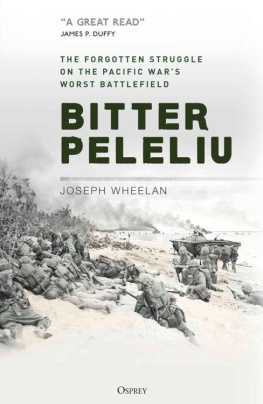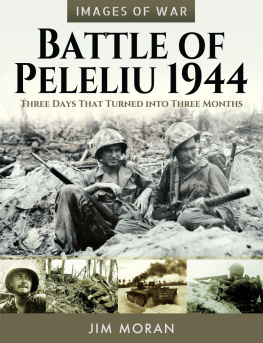Joseph Wheelan - Bitter Peleliu
Here you can read online Joseph Wheelan - Bitter Peleliu full text of the book (entire story) in english for free. Download pdf and epub, get meaning, cover and reviews about this ebook. year: 2022, publisher: Bloomsbury Publishing, genre: History. Description of the work, (preface) as well as reviews are available. Best literature library LitArk.com created for fans of good reading and offers a wide selection of genres:
Romance novel
Science fiction
Adventure
Detective
Science
History
Home and family
Prose
Art
Politics
Computer
Non-fiction
Religion
Business
Children
Humor
Choose a favorite category and find really read worthwhile books. Enjoy immersion in the world of imagination, feel the emotions of the characters or learn something new for yourself, make an fascinating discovery.
- Book:Bitter Peleliu
- Author:
- Publisher:Bloomsbury Publishing
- Genre:
- Year:2022
- Rating:4 / 5
- Favourites:Add to favourites
- Your mark:
- 80
- 1
- 2
- 3
- 4
- 5
Bitter Peleliu: summary, description and annotation
We offer to read an annotation, description, summary or preface (depends on what the author of the book "Bitter Peleliu" wrote himself). If you haven't found the necessary information about the book — write in the comments, we will try to find it.
Bitter Peleliu — read online for free the complete book (whole text) full work
Below is the text of the book, divided by pages. System saving the place of the last page read, allows you to conveniently read the book "Bitter Peleliu" online for free, without having to search again every time where you left off. Put a bookmark, and you can go to the page where you finished reading at any time.
Font size:
Interval:
Bookmark:


Contents

: Western Pacific Ocean
Were going to catch some red fire. Colonel Lewis B. Chesty Puller, responding to the suggestion that Peleliu would be a walkover.Sleep had eluded many of the men of the 1st Marine Division, even veterans of the divisions two previous Pacific War campaigns. They had never faced heavy enemy fire on the beach during the landings on Guadalcanal and Cape Gloucester but there was always a first time.
Western Pacific Ocean
It would be today.
They had meticulously oiled and polished their weapons, and their carrying gear was carefully packed, but their racing minds could not be so easily put in good order. It had made for a restless night.
On the crowded transports, reveille sounded at 3 a.m. Depending on the transport they were aboard, the Marines were awakened by either a bugle call over a ships loudspeaker, or a clanging bell, or with lights suddenly glaring in the stuffy, odoriferous holds, followed by the barked order, Hit the deck!
A thin crescent moon gleamed overhead, and choppy silver seas stretched beneath a sky that was startlingly clear, having been swept clean by a brisk northerly breeze. From the transports decks the men saw a sight that they would never forget: warships afloat for as far as they could see.
The Marines lined up in their mess for the landing day breakfast. Most of them got grilled steak and eggs, a Kiwi custom adopted as a Marine Corps tradition beginning at Tarawa. On some ships, steak sandwiches were piled on trays in the officers wardroom. Other messes offered scrambled eggs, bacon, coffee, and fresh fruit, or the option of a lighter meal of coffee, toast, and an apple. The latter alternative was a tacit recognition that anxiety about the impending landing tamped down appetites, and also that a big breakfast tended to worsen stomach wounds. Pfc Russell Daviss company breakfasted on black coffee, dry toast, and one apple or orange per man in a stand-up meal.
As the eastern sky brightened, preparations quickened aboard the amphibious assault fleet. At 5 a.m., aboard the Landing Ship, Tanks (LSTs) carrying the first-wave assault battalions, Marines began descending ladders to the tank decks and climbed into the tracked amphibian Landing Vehicles, Tracked LVTs, or amtracs idling in choking clouds of diesel smoke.
On the tank deck of LST 227, the roar of the amtrac engines was deafening blue, swirling exhaust began to clog my lungs and make my eyes water, despite the great fans whirling overhead, observed Captain George Hunt, commander of the First Marines K Company.
The sweltering heat caused sweat to bead on the mens faces; their jackets grew damp with perspiration and clung to them. A first sergeant began turning green and appeared ready to vomit, as Hunts men patiently waited for 227s bow doors to open and release them from the suffocating diesel fumes into the fresh oceanic air.
On other ships, rumbling power winches and creaking davits and pulleys hoisted shallow-draft Higgins Boats over the side preparatory to the landing troops on deck descending into the boats from cargo nets draped down the ships hulls. The Marines used the idle time before going down the nets to apply the last oil in the gun, the last whet to the knife. Some men daubed their cheeks with paint and burnt cork, giving them a fierce, primordial warrior appearance.
At 5:30 a.m., 15 minutes before sunrise, Admiral Jesse Oldendorf, the Fire Support Group commander, ordered his flotilla of battleships, cruisers, and destroyers to commence firing. The Marines watched from the railings of their transports, some of them chanting, Burn! Burn!, as explosions enveloped the island, 5 miles distant, in dense clouds of dust and smoke.
The bombardment was ear-splittingly loud. To Life magazine artist Tom Lea, the firing of the big guns sounded like the slamming of huge doors. Pfc E.B. Sledge of the Fifth Marines described each discharge as a thunder clap. The 16-inch shells tore through the air toward the island, roaring like locomotives; the Marines had to shout to be heard.
From all the firepower we were seeing and hearing we were wondering how in the world can anything survive? said Bill Tapscott of the Seventh Marines. It was beyond your imagination how anything could be alive, so we were beginning to feel pretty good.
The 1st Divisions three regiments would come ashore abreast on the five landing beaches: the First on the left, on White Beaches 1 and 2; the Fifth in the middle, on Orange Beaches 1 and 2; and the Seventh on the right, on Orange Beach 3.
The beaches spanned 2,500 yards of Pelelius southwest coast. If all went according to plan, 5,700 Marines from five battalions would alight from more than 300 amtracs and six-wheeled amphibious trucks called DUKWs during the assaults first 19 minutes with all their weapons except their big guns, which would be landed later. Within an hour, up to 9,000 men would be ashore.
But a major complication in the task of shuttling the assault troops to the beaches was Pelelius 500-yard-wide coral reef, which lay 700 yards from shore and guarded the shoreline like a stone moat. The treaded amphibians could crawl over the reef and swim the rest of the way to the beaches, but the flat-bottomed Higgins Boats could not. During the Normandy landings on June 6, Higgins Boats alone were used because there was no reef to cross.
There were just enough amtracs to carry the first three waves from their ships, over the reef, and across the lagoon to the beach.
Higgins Boats would have to take the next five waves from the transports to the so-called transfer control line, about a mile from shore. There, they would wait for the amtracs to return from landing the first three waves. The Marines in the Higgins Boats would then climb into the amtracs, which would turn around and carry them over the reef to the beaches.
In the last five assault waves would be more combat troops, supplies, support troops, and 30 medium Sherman tanks.
Admiral George Fort, who commanded the Marines transports and their convoy, and General Roy Geiger, who led the III Amphibious Corps, observed the deafening opening act from the command ship Mount McKinley . From the bridge of the troop transport DuPage , the 1st Division commander and his assistants, Generals William Rupertus and O.P. Smith, tensely watched the bombardment and their Marines emerging from the maws of the LSTs .
The first assault waves pushed off in the roaring, open-topped amtracs, amid billowing blue exhaust fumes. Beside the massive warships, the pygmy tractors crawled around them like bugs, wrote Captain Hunt.
The landing vehicles circled offshore like schooling fish before forming a ragged formation two and a half miles from shore the so-called line of departure.
At a signal at 8 a.m., the amtracs began their 30-minute approach to the beaches, led by more heavily armored amtracs LVT(A)s and nicknamed amtanks equipped with either a turreted 37mm gun, or a snub-nosed 75mm gun and .50-caliber machine guns. Under the aegis of the 3rd Armored Amphibian Tractor Battalion, the fire support amtanks would go in first, clearing a path for the riflemen behind them.
At the very tip of the murderous phalanx even ahead of the amtanks 18 landing craft armed with rocket launchers and four others equipped with 4.2-inch mortars barreled toward the beaches. Their job was to sweep the shoreline of any enemy soldiers that might meet the Marines at the waters edge.
Next pageFont size:
Interval:
Bookmark:
Similar books «Bitter Peleliu»
Look at similar books to Bitter Peleliu. We have selected literature similar in name and meaning in the hope of providing readers with more options to find new, interesting, not yet read works.
Discussion, reviews of the book Bitter Peleliu and just readers' own opinions. Leave your comments, write what you think about the work, its meaning or the main characters. Specify what exactly you liked and what you didn't like, and why you think so.





